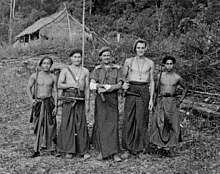
The Sandakan Death Marches were a series of forced marches in Borneo from Sandakan to Ranau which resulted in the deaths of 2,434 Allied prisoners of war held captive by the Empire of Japan during the Pacific campaign of World War II at the Sandakan POW Camp, North Borneo. By the end of the war, of all the prisoners who had been incarcerated at Sandakan and Ranau, only six Australians survived, all of whom had escaped. It is widely considered to be the single worst atrocity suffered by Australian servicemen during the Second World War.

The Borneo campaign or Second Battle of Borneo was the last major Allied campaign in the South West Pacific Area during World War II to liberate Japanese-held British Borneo and Dutch Borneo. Designated collectively as Operation Oboe, a series of amphibious assaults between 1 May and 21 July 1945 were conducted by the Australian I Corps, under Lieutenant-General Leslie Morshead, against Imperial Japanese forces who had been occupying the island since late 1941 – early 1942. The main Japanese formation on the island was the Thirty-Seventh Army under Lieutenant-General Masao Baba, while the naval garrison was commanded by Vice-Admiral Michiaki Kamada. The Australian ground forces were supported by US and other Allied air and naval forces, with the US providing the bulk of the shipping and logistic support necessary to conduct the operation. The campaign was initially planned to involve six stages, but eventually landings were undertaken at four locations: Tarakan, Labuan, North Borneo and Balikpapan. Guerilla operations were also carried out by Dayak tribesmen and small numbers of Allied personnel in the interior of the island. While major combat operations were concluded by mid-July, localised fighting continued throughout Borneo until the end of the war in August. Initially intended to secure vital airfields and port facilities to support future operations, preparatory bombardment resulted in heavy damage to the island's infrastructure, including its oil production facilities. As a result, the strategic benefits the Allies gained from the campaign were negligible.

The Battle of Tarakan was the first stage in the Borneo campaign of 1945. It began with an amphibious landing by Allied forces on 1 May, code-named Operation Oboe One; the Allied ground forces were drawn mainly from the Australian 26th Brigade, but included a small element of Netherlands East Indies personnel. The main objective of the landing was the capture of the island's airfield. While the battle ended with success for the Allied forces over the Japanese defenders, this victory is generally regarded as having not justified its costs. The airfield was so heavily damaged that it ultimately could not be repaired in time to make it operational for other phases of the Allied campaign in Borneo.
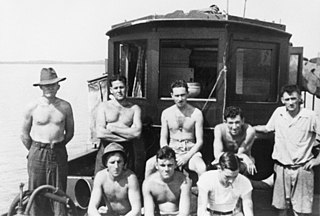
Z Special Unit was a joint Allied special forces unit formed during the Second World War to operate behind Japanese lines in South East Asia. Predominantly Australian, Z Special Unit was a specialist reconnaissance and sabotage unit that included British, Dutch, New Zealand, Timorese and Indonesian members, predominantly operating on Borneo and the islands of the former Dutch East Indies.
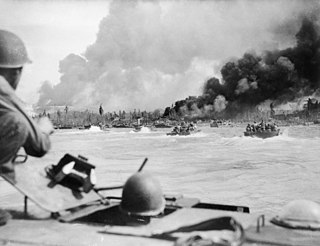
The Battle of Balikpapan was the concluding stage of Operation Oboe, the campaign to liberate Japanese-held British and Dutch Borneo. The landings took place on 1 July 1945. The Australian 7th Division, composed of the 18th, 21st and 25th Infantry Brigades, with a small number of Netherlands East Indies KNIL troops, made an amphibious landing, codenamed Operation Oboe Two, a few miles north of Balikpapan. The Allied invasion fleet consisted of around 100 ships. The landing had been preceded by heavy bombing and shelling by Australian and US air and naval forces. The Allied force totalled 33,000 personnel and was commanded by Major General Edward Milford, while the Japanese force, commanded by Rear Admiral Michiaki Kamada, numbered between 8,400 and 10,000, of which between 3,100 and 3,900 were combatants. After the initial landing, the Allies secured the town and its port, and then advanced along the coast and into the hinterland, capturing the two Japanese airfields. Major combat operations concluded around 21 July, but were followed by mopping-up operations, which lasted until the end of the war in mid-August. Australian troops remained in the area until early 1946.
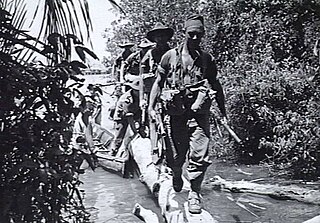
The Battle of North Borneo took place during the Second World War between Allied and Japanese forces. Part of the wider Borneo campaign of the Pacific War, it was fought between 10 June and 15 August 1945 in North Borneo. The battle involved a series of amphibious landings by Australian forces on various points on the mainland around Brunei Bay and upon islands situated around the bay. Japanese opposition to the landings was sporadic initially, although as the campaign progressed a number of considerable clashes occurred and both sides suffered significant casualties, although major combat was largely restricted to Labuan and around Beaufort. On the mainland, while Allied conventional operations focused largely on the coastal areas around Brunei Bay, guerrilla forces consisting of Dayak tribesmen and small numbers of Allied personnel from the Services Reconnaissance Department fought an unconventional campaign in the interior. The Allies were successful in seizing control of the region. Nevertheless, many of the strategic gains that possession of North Borneo provided were ultimately negated by the sudden conclusion of the war in August 1945.
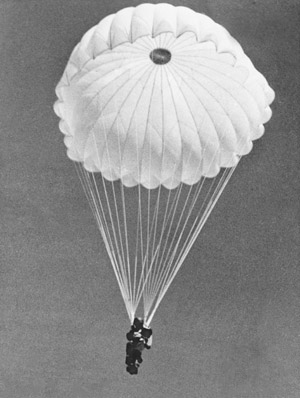
No. 200 Flight was a Royal Australian Air Force special duties flight of World War II. The flight was formed in February 1945 to support the Allied Intelligence Bureau (AIB) and saw action over Borneo and the Netherlands East Indies (NEI) from March that year until the end of the war in August. No. 200 Flight was disbanded in December 1945.

The Battle of Labuan was an engagement fought between Allied and Imperial Japanese forces on the island of Labuan off Borneo during June 1945. It formed part of the Australian invasion of North Borneo, and was initiated by the Allied forces as part of a plan to capture the Brunei Bay area and develop it into a base to support future offensives.

Lionel Colin Matthews, was an Australian Army officer in World War II. He was posthumously awarded the George Cross, the highest award for heroism or courage not in the face of the enemy, that could be awarded to a member of the Australian armed forces at the time. Matthews was born in Adelaide, South Australia, and was schooled there before moving to Victoria. He trained as a signalman in the Royal Australian Naval Reserve before joining the Militia in April 1939. Commissioned as an officer in the Australian Corps of Signals, Matthews transferred to the 8th Division of the Second Australian Imperial Force after the outbreak of World War II.
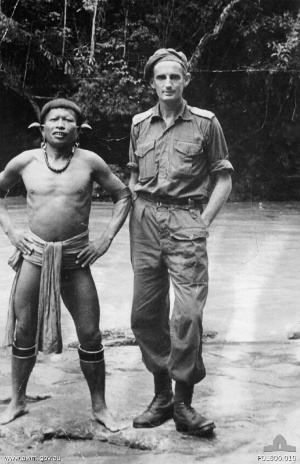
Major Gordon Senior 'Toby' Carter DSO was a New Zealand surveyor and road engineer who worked in Sarawak, Borneo prior to World War II for Shell Oil. He enlisted with the British Army during the war, and served in the Royal Australian Engineers and later in Z Special Unit in Borneo, where he was the Officer in Command of the Semut II operation in the Kelabit Highlands of Sarawak. In 1962 Carter had the initial idea for and was the driving force behind the establishment of both the Kinabalu National Park and the Kundasang War Memorial and Gardens near Mount Kinabalu in Sabah.
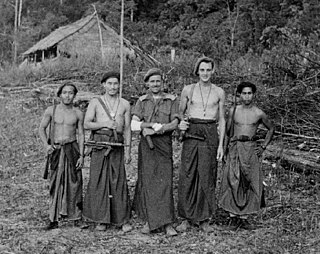
Lieutenant-Colonel Francis George Leach "Gort" Chester DSO, OBE was a British soldier who led several Z Special Unit operations in Borneo during World War II.

The Landing at Jacquinot Bay was an Allied amphibious operation undertaken on 4 November 1944 during the New Britain Campaign of World War II. The landing was conducted as part of a change in responsibility for Allied operations on New Britain. The Australian 5th Division, under Major General Alan Ramsay, took over from the US 40th Infantry Division, which was needed for operations in the Philippines. The purpose of the operation was to establish a logistics base at Jacquinot Bay on the south coast of New Britain to support the 5th Division's planned operations near the major Japanese garrison at Rabaul.
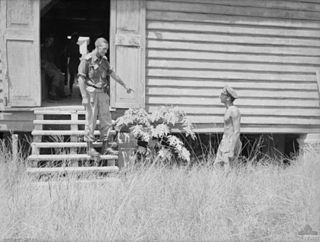
Robert Kerr "Jock" McLaren MC & Bar was a decorated Australian Army officer, who rose from enlisted rank and was noted for his involvement in guerrilla operations against the Japanese during World War II.

Before the outbreak of World War II in the Pacific, the island of Borneo was divided into five territories. Four of the territories were in the north and under British control – Sarawak, Brunei, Labuan, an island, and British North Borneo; while the remainder, and bulk, of the island, was under the jurisdiction of the Dutch East Indies.

The Jesselton revolt was a revolt by a resistance movement known as the Kinabalu Guerrillas, comprising local Chinese, indigenous peoples, Eurasian and Sikh Indian of Jesselton, North Borneo and led by Albert Kwok, against the Japanese occupying forces of North Borneo.
The 56th Independent Mixed Brigade was an Imperial Japanese Army unit of World War II. It was raised in June 1944 to reinforce the defences of Japanese-occupied Borneo, and was initially stationed in the north-east of the island. In early 1945 most of the brigade's units were ordered to move to the Brunei Bay area of west Borneo, with the brigade's personnel subsequently making a difficult march across the centre of the island.

Operation Semut was a series of reconnaissance operations carried out by Australia's Z Special Unit in 1945, during the final stages of World War II. This operation was the part of the Borneo Campaign, and was undertaken in Sarawak, northwestern Borneo, in support of Allied operations to secure North Borneo. Another closely related operation codenamed Agas was carried out concurrently in North Borneo. Both operations combined and relayed their intelligence through the Stallion Project to Australian forces and carried out guerrilla warfare against the Japanese in the region with the full support of the local population. A total of four operations were undertaken under the auspices of Operation Semut, concluding in September and October 1945.
Operation Adder was a military operation conducted by Australia's Services Reconnaissance Department in Timor during World War II in August 1944. A party consisting of two Australian soldiers, Captain John Grimson and signaller Ernest Gregg, and three Portuguese Timorese, was dropped on Timor.
The 25th Independent Mixed Regiment was a regiment of the Imperial Japanese Army (IJA) active during World War II. It was raised in July 1944, and deployed to Borneo in September that year. Elements of the regiment briefly saw combat against the United States Army on islands near Tawi-Tawi Island and against Australian forces during the Battle of North Borneo.

Naval Base Borneo and Naval Base Dutch East Indies was a number of United States Navy Advance Bases and bases of the Australian Armed Forces in Borneo and Dutch East Indies during World War II. At the start of the war, the island was divided in two: British Borneo and Dutch East Indies. Both fell to the Empire of Japan, Japan occupied British Borneo and the Dutch East Indies in 1942 until 1945.
